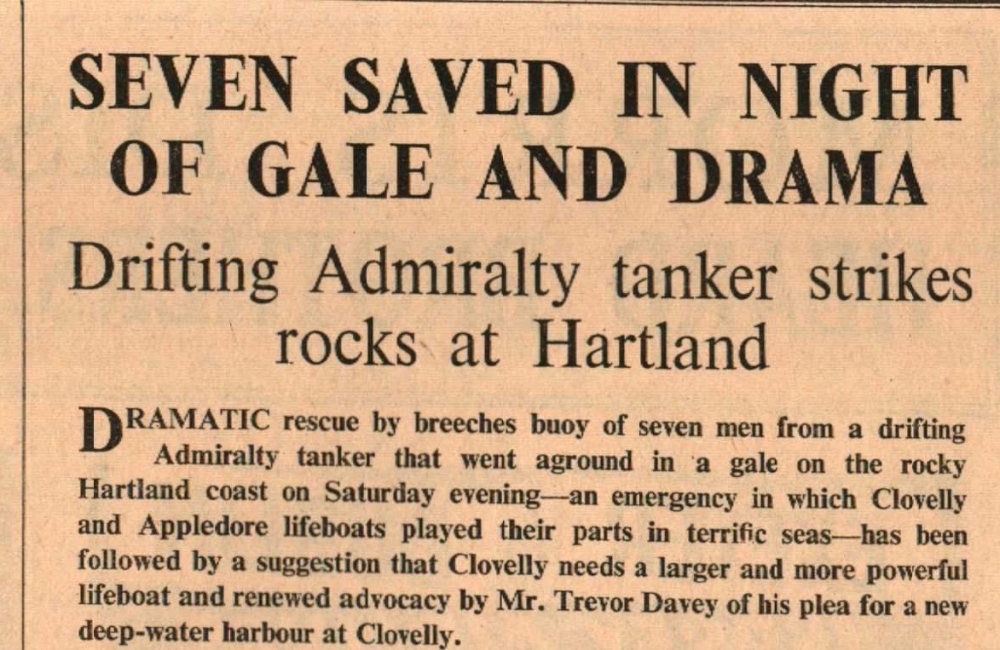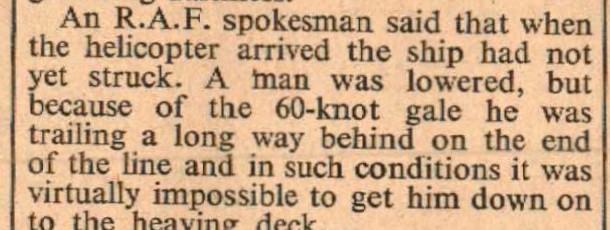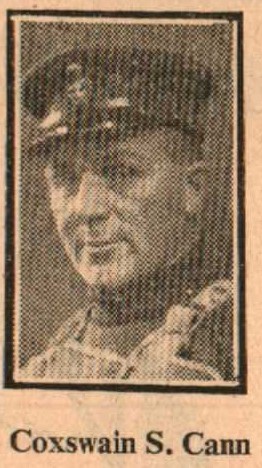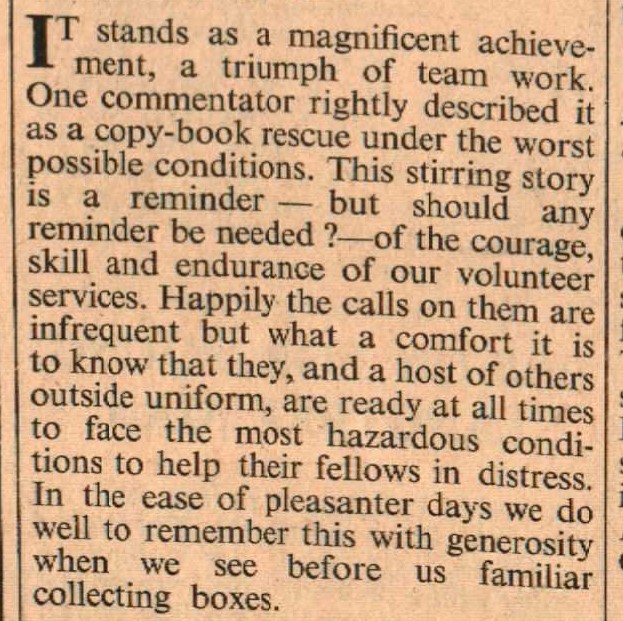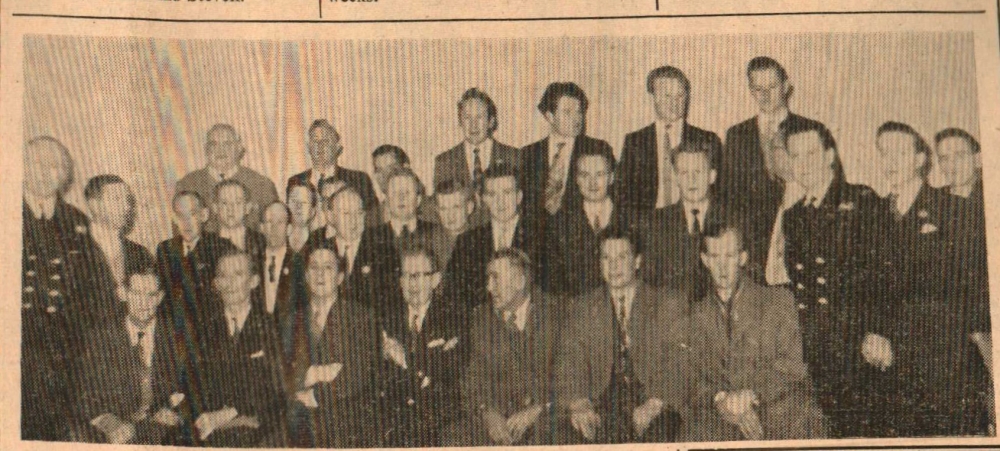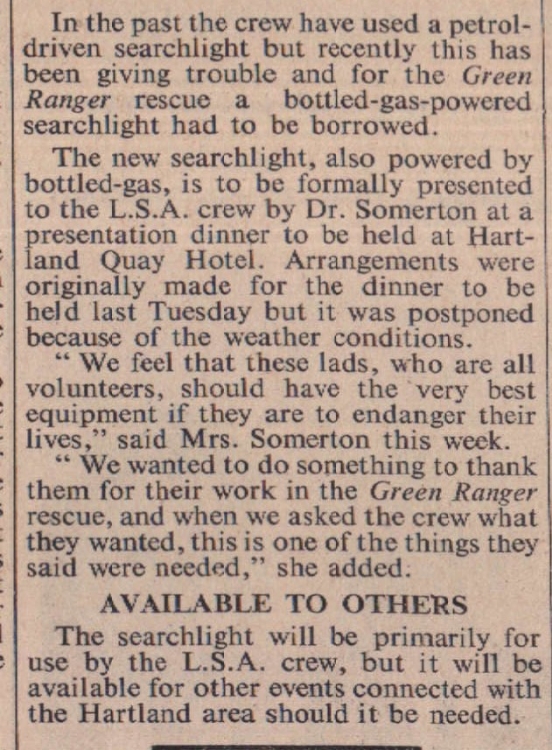RFA Green Ranger
Viewed at dawn on Sunday, but a few hours after her crew of seven had been rescued by breeches buoy, the Royal Fleet Auxiliary tanker ‘Green Ranger’ ashore near Long Peak on Hartland’s rocky coast.
The drama began when the tug Caswell which was towing the 3,500 ton Admiralty tanker – a ‘dead ship’ – from Plymouth to Cardiff for repairs, was forced by mountainous seas to slip the tow rope off Hartland Point.
In no time the Green Ranger was swept towards the rockbound shore and before ships that raced to her assistance could get near she struck the rocks beneath the towering, remote cliffs. Before she struck, however, rescue services had been alerted. Local coastguards and Hartland life-saving crew were battling through the 70 mile an hour gale over fields to the cliff top and calls had gone out to the Appledore and Clovelly lifeboats and to the RAF helicopter rescue service at Chivenor. What followed was in the highest traditions of all the services.
Directing operations from the shore was Mr George Read, coastguard district officer, Hartland district, backed by station officer Mr H E Hales, in charge of Hartland coastguards. About 20 members of Hartland LSA company were reinforced by a large number of other local people – “We had tremendous help” the Gazette was told – and by a party from Bude LSA under Mr Bickle. Tractors were used to carry equipment across the fields to the cliff top and searchlights were set up.
Said Mr Read: “When we arrived it was dark. There was a force 10 gale with frequent hail showers. We could not estimate the distance of the ship from the shore, but we fired two rockets from the clifftop. Neither made contact. We realised that this method was out of the question in such conditions and as it was high water we decided to wait until such time as we could get to the bottom. We had to wait quite a while for the tide to ebb and then we started the rescue operation. Because of the terrific wind and the roar of the sea one could not make one’s self heard by shouting and orders had to relayed from one person to another. Three men went down the cliffs to investigate the possibility of taking the gear down to the beach. Following their report we decided to attempt it. The men took down seven heavy rockets, four lines, a whip and a hawser – quite an achievement. The last section of the cliff was almost vertical and this part could not climbed without the help of a rope. We got down on to the beach and then came the highly dangerous job of getting out to the rocks, where we would be near enough to the tanker to fire a rocket. The rocks were slippery and the spray was driving in from the sea all the time.
District Officer Read said the rescued men seemed quite overwhelmed when they were brought ashore on the breeches buoy. Cmdr H D Smallwood, like District Officer Read, praised the men of the rescue team for their outstanding skill and courage. In an hour they got seven men ashore and then came the climb up the 400-500ft cliffs.
When he returned from working on the cliff face Mr L Goaman, of Elmscott Farm, Hartland, which was used as HQ by the rescue party and where refreshments were provided, described the gale as ‘so fierce you could not open your mouth and you could hardly stand.’
Meanwhile there had been tremendous drama at sea as the Clovelly and Appledore lifeboats battled their way towards the wreck. The helicopter, piloted by Flight-Lieut J Egginton, had long since returned to base, it having been found after repeated attempts that in the terrific gale it was impossible to approach close enough to effect a rescue in gathering darkness.
By what Captain Pat Brennan (hon. secretary of the Appledore branch of RNLI) described as “an astonishing feat of seamanship”, Coxswain Sidney Cann brought the Appledore lifeboat around the bows of the wreck to place her between the ship and the shore.
This was the first real test that the Appledore new lifeboat had undergone and Coxswain Cann said that she behaved splendidly in “one of the worst trips in my experience. It was the most dangerous of the lot.” Coming from Cox’n Cann that means a great deal for he has served in Appledore lifeboats since 1913 and has been cox’n since 1933. Past retiring age, he has had three extensions of service.
An indication of the near incredibility of Cox’n Cann’s feat is that one man aboard the tanker did see the rescue vessel and told the rest of the crew. “Conditions were so terrible that I do not think anyone believed what I was saying,” said Mr Joe Bennet of Avonmouth. “The sea was so rough and the conditions were so bad that we certainly never expected to see a rescue from this direction.”
But for great good fortune a night of heroism that ended happily could well have been a night of tragedy for Clovelly families.
What happened when the boat ‘took a risk’ and decided to come in was described by Mr W H Prince, who is chairman of the local lifeboat committee, “One very large sea hit her broadside. One more big sea and I think she would have capsized but luckily the next was smaller and she missed it. It was the worst launching the crew has experienced in 60 years.” Making a typical understatement, the coxswain, Mr William Braund admitted “It was pretty bad. Older men than me say the conditions were the worst they had ever known. We had plenty of water aboard.”
The nine-hour ordeal of the crew of the tanker ended at the Seamen’s Mission at Appeldore where after a meal and sleep, they lavishly praised all who had taken part in the rescue operation. Mr Donald Marr, of Clifton, Bristol, told how their ordeal began.
The skipper, Mr Donald Cerman-Patterson, of Whitchurch, Cardiff, said the master of the tug did the only thing he could in slipping the tow rope. They first realised the tug was in trouble when she started to send up rockets. Mr Joe Bennett, of Avonmouth, said that when the tanker went ashore the crew could see men trying to reach them from the cliff. “We saw them fire a rocket and then we could see them working their way down the cliff until they could fire a rocket out to us from the beach. They did a wonderful job.”
Ubiquitus writes Mission accomplished
Team work
The seven members of the naval tanker 'Green Ranger' rescued just under a fortnight ago by breeches buoy when their vessel drifted ashore in a gale at Hartland, photographed with Coastguards, Lifesaving Apparatus teams and other helpers at the tea following the rescue thanksgiving service.
In an article in February 1963, it was stated that as a token of recognition of the important part they played in the rescue, Hartland Lifesaving Apparatus crew are being given a new portable searchlight by Dr and Mrs W K Somerton, of Hartland, who were present when the rescue was made.
More on RFA Green Ranger can be found HERE and Remembered – Hartland Parish Council
The Appledore crew received RNLI awards - Awards To Appledore Lifeboat Crew
November 1962

